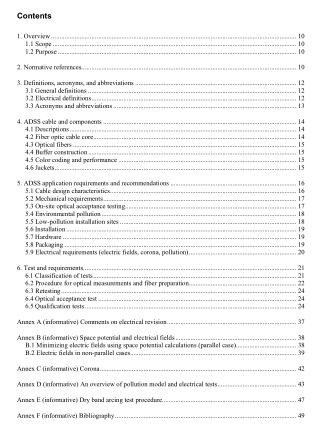IEEE 1222-2019 pdf download.IEEE Standard for Testing and Performance for All-Dielectric Self-Supporting (ADSS) Fiber Optic Cable for Use on Electric Utility Power Lines
4. ADSS cable and components
4.1 Descriptions
The ADSS cable shall consist of coated glass optical fibers grouped in one or more protective dielectric units surrounded by or attached to suitable dielectric strength members and jackets. The cable shall not contain metallic components. The cable shall be designed to meet the requirements under all specified installation conditions, operating temperatures, and environmental loading.
4.2 Fiber optic cable core
The fiber optic cable core shall be all-dielectric and shall contain coated glass optical fibers that are protected from mechanical, environmental, and electrical stresses. Materials used within the core shall be compatible with one another, shall not degrade under the electrical stresses to which they may be exposed, and shall not evolve hydrogen in quantities sufficient to degrade optical performance of fibers within the cable.
4.2.1 Fiber strain allowance
The cable shall be designed such that fiber strain does not exceed the limit allowed by the cable manufacturer under the operational design limits (MRCL) of the cable. Maximum allowable fiber strain is generally a function of the proof test level, and the strength and fatigue parameters of the coated glass fiber. The maximum fiber strain shall not exceed the limit specified in 6.5.1.2. The optical fiber attenuation increase while under fiber strain shall also meet the requirements listed in 6.5.1.2.
4.2.2 Central strength element
If a central strength element is necessary, it shall be of reinforced plastic, epoxy glass, or other dielectric material. If required, this element shall provide the necessary tensile strength to limit axial stress on the fibers and minimize fiber buckling due to cable contraction at low temperatures. The strength element shall also meet the stress strain fatigue requirements in 6.5.1.3.
4.2.3 Buffer tube filling compound Loose buffer tubes shall be water-blocked with a suitable material compatible with the tubing material, fiber coating, and coloring, to protect the optical fibers and prevent moisture ingress. 4.2.4 Cable core water blocking compound The design of the cable may include suitable water blocking materials in the interstices to prohibit water migration along the fiber optic cable core. The water blocking material shall be compatible with all components with which it may come in contact.
4.2.5 Binder/tape
A binder yarn or yarns and/or a layer or layers of overlapping non-hygroscopic tape(s) may be used to hold the cable core elements in place during application of the jacket.
4.2.6 Inner jacket
A protective inner jacket or jackets of a suitable material may be applied over the fiber optic cable core, isolating the cable core from any external strength elements and the cable outer jacket.
4.3 Optical fibers
Single-mode fibers such as dispersion-unshifted, dispersion-shifted, or non-zero dispersion shifted as well as multimode fibers with 50/125 µm or 62.5/125 µm core/clad diameters are considered in this standard. All single-mode fibers shall meet the requirements of IEC 60793-2-50. 8 All multimode fibers shall meet the requirements of IEC 60793-2-10. The core and the cladding shall consist of all glass that is predominantly silica (SiO 2 ). The coating is usually made from one or more materials, such as acrylate, and shall protect the fiber during manufacture, handling, and operation.
4.4 Buffer construction
The individually coated optical fiber(s) or fiber ribbon(s) may be surrounded by a tube for protection from physical damage during fabrication, installation, and operation of the ADSS cable. Loose buffer construction is a typical type of protection that may be used to isolate the fibers. The fiber coating shall be strippable for splicing and termination.
4.4.1 Loose buffer
Loose buffer construction shall consist of a tube that surrounds each fiber or fiber group such that the inner diameter of the tube is greater than the outside diameter of the fiber or fiber group. The interstices inside and outside the tube shall contain a water blocking material.
4.5 Color coding and performance
Color coding is essential for identifying individual optical fibers and groups of optical fibers. The colors shall be in accordance with EIA/TIA-598. The original identification of fibers and units shall remain discernible throughout the design life of the cable when cleaned and prepared per manufacturer’s recommendations.IEEE 1222 pdf download.IEEE 1222-2019 pdf download
IEEE 1222-2019 pdf download

Leave a Reply